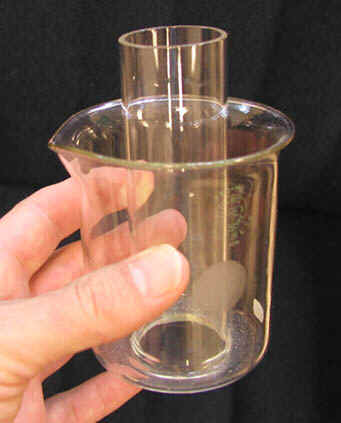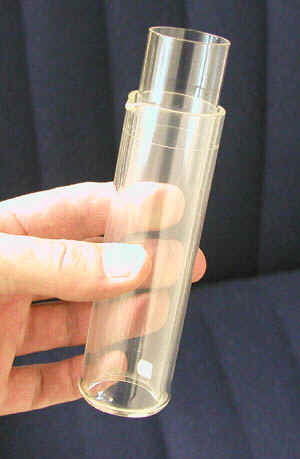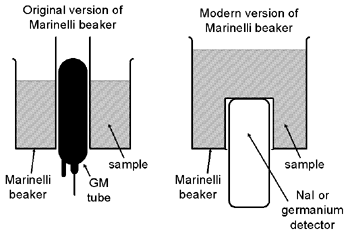Marinelli Beakers (ca. 1950)

The following footnote regarding the Marinelli beaker is found in a report by R.F. Hill, G.J. Hine and L.D. Marinelli (1950) of the Sloan-Kettering Institute in New York: “This equipment first designed by one of the present authors (L.D.M.) and in use in this laboratory since 1943, can now be obtained from Technical Associates, Inc. Glendale, California.”
In the 1940s and 1950s, the main application of the Marinelli beaker was the analysis of I-131 in liquids (e.g., urine). The original version of the Marinelli beaker, pictured here, consisted of a Pyrex laboratory beaker with a central hollow tube projecting from the bottom. A detector, usually a glass GM tube designed for gamma counting, was positioned in the central tube while the beaker was filled with the sample. Since the sample effectively surrounded the detector, the counting efficiency was greater than would be the case if the sample were in any other type of container.

A laboratory often used Marinelli beakers of different sizes—small beakers for small volume samples and large beakers for large volume samples. While it was always possible to increase the volume of a small sample by dilution so that it would fill a large beaker, this sacrificed counting efficiency.
Until the mid-to-late1950s when liquid scintillation counters came along and gamma scintillators (NaI crystals) became larger and more widely available, the major options for counting liquid samples were Marinelli beakers, jacketed (annular) GM tubes, and dipping GM tubes. Since Marinelli beakers could hold larger volume samples than annular GMs, they had a higher counting efficiency for gamma rays. On the other hand, their efficiency for beta particles was lower than that of annular GM tubes because the betas had to penetrate the glass of the beaker as well as the GM tube wall. Dipping GM tubes, which were dipped into the radioactive solution, were primarily used for beta emitters. While the problem was not as severe as with the annular GM, they could be difficult to clean - a potential problem with long-lived nuclides.
A different type of alternative was to dry the sample and count it with an end window GM or electroscope (e.g., the Landsverk Model L-75). However, the preparation of dried samples was difficult to perform in a reproducible manner and it risked the volatilization of the iodine.

As NaI detectors became more widely available, workers started to use the type of sample container that most people think of today as the Marinelli beaker: a relatively large plastic jar/beaker with an annular bottom that slid over the NaI crystal (e.g., Haigh, 1954 and Dratz, 1957). Sometimes referred to as a “well-bottom” container, the end of the well was sealed so that the container “hung” from the top of the detector.
Kindly donated by Ron Kathren.
References
- Bruner, H.D. and Perkinson, J.D. A Comparison of Iodine-131 Counting Methods. Nucleonics October 1952, p. 57.
- Marinelli, L.D. and Hill, R.F. in Brookhaven National Laboratory Conference Report BNL-C-5, 1948, p.98.
- Dratz, A.F. Well-Bottom Container Improves Gamma Counting, Nucleonics August 1957, p. 83.
- Hill, R.F., Hine, G.J. and Marinelli, L.D. The Quantitative Determination of Gamma Radiation in Biological Research, Am. J. Roentg. and Radium Therapy, February 1950, p. 160.
